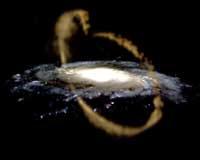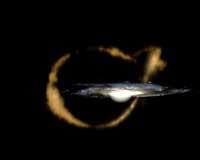Galaxies galaxies galaxies galaxies
2001/03/09 Roa Zubia, Guillermo - Elhuyar Zientzia
The most accepted theory of the current formation of galaxies is that the first to be formed were the small galaxies. These small galaxies gradually came together and larger ones emerged. Over time, large galaxies are swallowing small. These types of processes have been observed in remote systems, although not directly.

Despite suspicions that the milky way also works this way, astronomers have not been aware for many years of it. But in 1994 the Sagittarius galaxy was discovered, next to the Milky Way and on the opposite side of us. Sagittarius is in orbit around the Milky Way, but already within the diffuse outer boundary.
Since its discovery, the Sagittarius galaxy has been considered a semi-detached galaxy, that is, with a lot of matter already lost and the Milky Way has to be swallowed up. Thus, in theory you can find a double ring shaped footprint formed by stars. The ring had to surround the entire Milky Way. The biggest problem of detection is that it constitutes a very fine footprint and hardly separable.
In 1998, researchers from the University of Michigan discovered part of this footprint and were able to concretize the line to the Sagittarius core environment. However, according to the theory, there was a second extended part in the opposite direction and that would probably turn the entire Milky Way. The second part of the footprint would be more difficult than the previous one because it crossed the plane of our galaxy and hid behind the area.

Astronomers at the IAC Institute in Spain have searched for this piece of footprint through the 2.5-metre diameter "Isaac Newton" telescope at the Roque de los Muchachos Observatory. They start from the dynamic models of the Sagittarius galaxy. Finally, a series of young stars have been detected that confirm the existence of the entire arc of the footprint announced by theoretical models.
The report of this discovery will be published in the specialized journal Astrophysical Journal Letters on March 10. The authors have claimed that it is a direct proof that large galaxies eat small. However, to get to see the entire footprint, new groups of stars are sought. The objective is to analyze, among other aspects, the influence of the swallowing process in the Milky Way.




